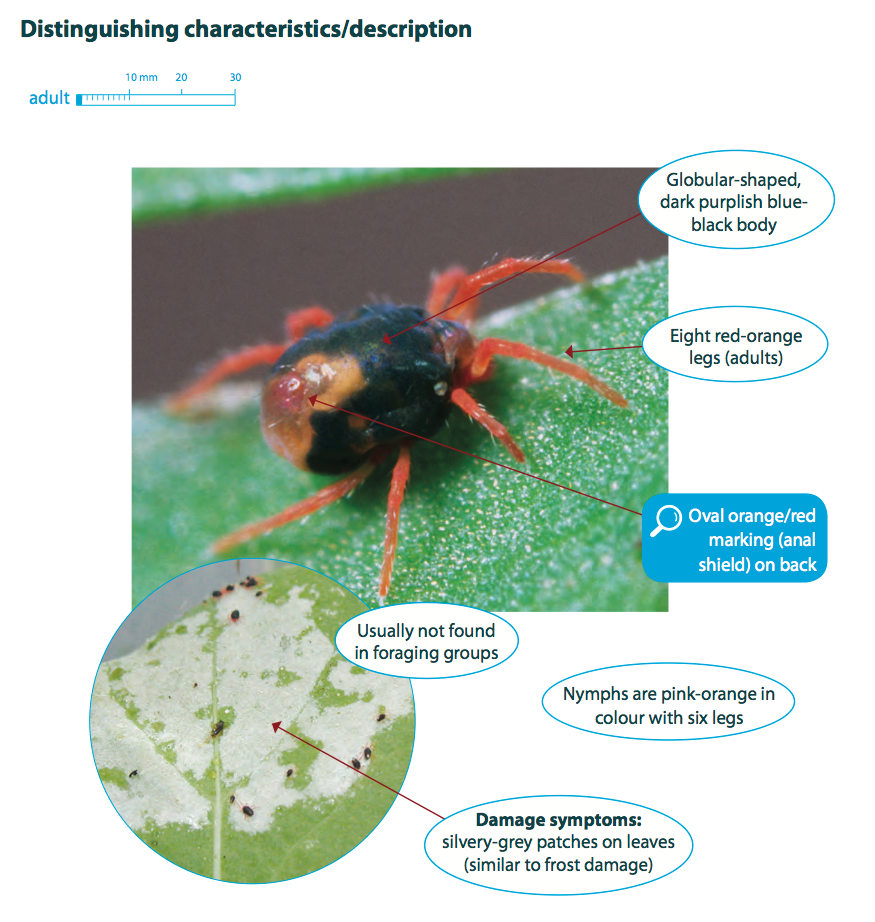Blue oat mites are one of the most significant pest mites in cropping and pastoral areas of Victoria and New South Whales, and we have been receiving reports of high numbers in some areas this season. Blue oat mites can require different management strategies to other mites, so identification is important.
In this article we will share recent reports and information on how to identify and manage blue oat mite species.
Reports
Blue oat mites are active in the cool, wet part of the year, usually between April and late October. We have seen a recent rise in reports, with significant numbers found in lucerne, cereals and pastures in parts of southern and northern NSW, as well as central Victoria. Given the favourable spring conditions, they are also likely to be building up in many other regions of south-eastern Australia.
Blue oat mite identification
Blue oat mites can be distinguished from other mites by their blue-black coloured body and characteristic red mark on their back.
They are often mistaken for redlegged earth mites (Halotydues destructor) due to their similar appearance and the fact they can be present at the same time of year. The difference between these species is the red mark on the back of the blue oat mite and the fact they are usually found singularly or in very small groups, unlike larger groupings of redlegged earth mite. Also, redlegged earth mite are typically not found further north than Dubbo, in NSW.

Once thought to be a single species, it is now known that there are three pest species of blue oat mites in Australia: Penthaleus major, Penthaleus falcatus and Penthaleus tectus. It is impossible to tell them apart using morphological characteristics without a microscope. However, each species has different distributions and host pant preferences.
P. major is the most common species in eastern Australia, and is widespread across South Australia, Victoria, NSW and Tasmania. It mostly feeds on pasture grasses, cereals and pulses.
P. falcatus is also found in South Australia, Victoria, NSW and Tasmania (although less frequently than P. major) and is commonly found on the dandelion weed Hypochaeris glabra and the daisy Helminthotheca echioides. It mostly attacks canola crops, and occasionally pastures.
P. tectus is found in north-western Victoria and north-eastern NSW and has a preference for cereals but can also be found on pastures and some pulses.
See the blue oat mite PestNote for further information.
Differences in pesticide tolerance
In addition to different host preferences and distributions, the three blue oat mite species have different sensitivities to pesticides.
P. falcatus has a significantly higher tolerance to pyrethroids and organophosphates than other blue oat mite species (and the redlegged earth mite). P. major and P. tectus have lower tolerances to pesticides and are more easily controlled.
It is important to note that Timerite®, an effective tool in the management of redlegged earth mites, is not effective against any of the blue oat mite species.
Monitoring and management
Typical mite damage appears as ‘silvering’ or ‘whitening’ of the attacked foliage. Distortion, or shrivelling can occur in severe infestations. Monitoring involves inspecting susceptible pastures and broad-acre crops from autumn to spring for this damage and for the presence of mites. Mites are best detected feeding on the leaves in the morning or on overcast days. If mites are not observed on plant material, also inspect the soil.
Blue oat mites are most damaging to emerging crops and pastures. By September/October blue oat mite populations can be quite large, however chemical control is rarely required in established crops.
If chemical control is warranted, it is best to determine the species before deciding on the most appropriate product and ensure pesticide sprays are applied at the full registered rate. Feel free to contact the Cesar Australia PestFacts team if you’d like assistance in determining the likely species you might have.
Cultural controls, such as rotating crops or pastures with non-host crops can reduce blue oat mite colonisation, reproduction and survival – decreasing the need for chemical control. This is something that can be factored into planning for next season if blue oat mites are found in very high densities in particular paddocks this spring. As above, it helps to know what the likely blue oat mite species is if considering this option.
As with all earth mites, it is important to minimise the use of broad-spectrum sprays because natural enemies such as French Anystis mites, snout mites, small predatory beetles and spiders can play a role in controlling blue oat mite populations. Leaving shelterbelts or refuges between paddocks will help maintain natural enemy populations.
Acknowledgements
Thank you to Jo Powells (South East Local Land Services), Matt Nihill and Chris Dunn (Nutrien) for their reports and to Paul Umina for contributions to this article.
Cover image: Photo by Andrew Weeks, Cesar Australia





